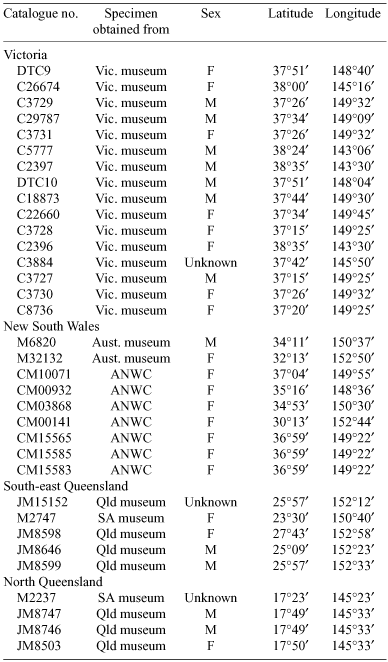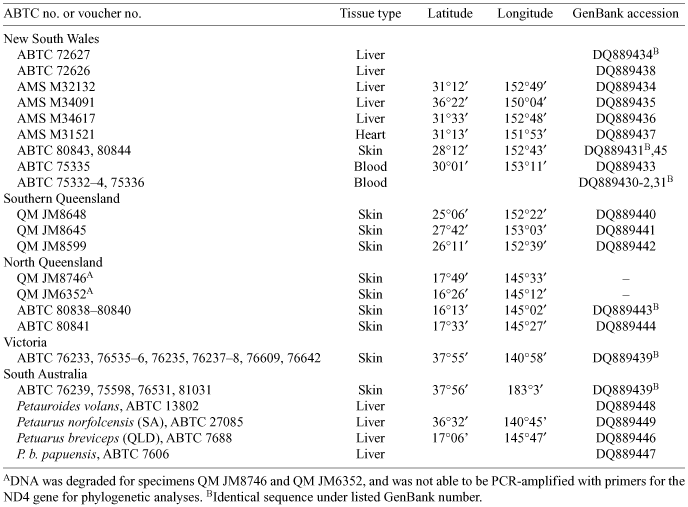Conservation units and phylogeographic structure of an arboreal marsupial, the yellow-bellied glider (Petaurus australis)
Meredeth Brown A C , Huw Cooksley B C , Susan M. Carthew A and Steven J. B. Cooper C D EA School of Earth & Environmental Sciences, The University of Adelaide, DP312, Adelaide, SA 5005, Australia.
B School of Molecular and Biomedical Science, The University of Adelaide, Adelaide, SA 5005, Australia.
C Evolutionary Biology Unit, South Australian Museum, North Terrace, Adelaide, SA 5000, Australia.
D Centre for Evolutionary Biology and Biodiversity, The University of Adelaide, SA 5005, Australia.
E Corresponding author. Email: cooper.steve@saugov.sa.gov.au
Australian Journal of Zoology 54(5) 305-317 https://doi.org/10.1071/ZO06034
Submitted: 20 April 2006 Accepted: 2 August 2006 Published:
Abstract
Subspecific status has often been used as a surrogate for conservation unit, but does not always reflect intraspecific lineages with different evolutionary histories. One contentious case of subspecific classification occurs in the yellow-bellied glider (Petaurus australis), a marsupial species showing considerable decline in population size and requiring conservation management. Our aim was to assess the current subspecific status of populations and define units of conservation using a combination of phylogeographical analyses of mitochondrial DNA and morphological analyses. Analyses of the mitochondrial ND4 gene provided evidence for significant phylogeographic structure within P. australis. Isolated populations in north Queensland (NQ) and Victoria/South Australia were genetically distinct from populations in New South Wales and southern Queensland. Morphological analyses provided little evidence for discrimination of populations, although NQ specimens were generally smaller in size than southern forms. Our analyses do not support the classification of subspecies P. a. reginae for the original type specimen from southern Queensland. Taking into account other behavioural and ecological data, and the disjunct distribution of NQ populations from southern populations, we propose that the NQ population represents a distinct Evolutionarily Significant Unit, a lineage showing highly restricted gene flow from the rest of the species.
Acknowledgments
We thank numerous volunteers for their assistance in the field, particularly those who helped us in north Queensland: D. Funnell, M. Lee, J. Blackwood, R. Russell and P. Latch. K. Saint and T. Bertozzi (SA Museum) are thanked for technical assistance in the laboratory. S. Ingleby (Australian Museum), W. Longmore (Museum of Victoria), C. Kemper (SA Museum), R. Palmer (Australian National Wildlife Collection) and H. Janetzki (Queensland Museum) are thanked for their cooperation in providing skulls for measurement. We also thank R. Goldingay, S. van Dyke and L. Vogelnest for providing skin biopsies and blood from yellow-bellied gliders. A. Hugall, K. Helgen and, particularly, M. Lee are thanked for their helpful advice concerning morphometric and genetic analyses. Field and laboratory work was carried out under Animal Ethics W-13-2002 and W-10-99, DSE permit numbers (Vic.) 10001364, 10001803 and 10002392, and EPA (north Qld) permit numbers ATH04/018, ATH04/019 and WISP01808404. This research was funded from a University of Adelaide Research Grant, the Mark Mitchell Foundation, Nature Foundation, The Department of Environment and Heritage (Wildlife Conservation Fund), Hancock Victorian Timber Plantations, the Royal Zoological Society of South Australia/Rotary Robin Fund, Australian Geographic and The University of Adelaide. Finally, we thank our anonymous reviewers for their helpful comments on the manuscript.
Arevalo, E. , Davis, S. K. , and Sites, J. W. (1994). Mitochondrial DNA sequence divergence and phylogenetic relationships among eight chromosome races of the Sceloporus grammicus complex (Phrynosomatidae) in central Mexico. Systematic Biology 43, 387–418.
| Crossref | GoogleScholarGoogle Scholar |
Carthew, S. M. , Goldingay, R. L. , and Funnell, D. L. (1999). Feeding behaviour of the yellow-bellied glider (Petaurus australis) at the western edge of its range. Wildlife Research 26, 199–208.
| Crossref | GoogleScholarGoogle Scholar |
Fraser, D. J. , and Bernatchez, L. (2001). Adaptive evolutionary conservation: towards a unified concept for defining conservation units. Molecular Ecology 10, 2741–2752.
| PubMed |
Goldingay, R. , and Possingham, H. (1995). Area requirements for viable populations of the Australian gliding marsupial. Biological Conservation 73, 161–167.
| Crossref | GoogleScholarGoogle Scholar |
Huelsenbeck, J. P. , and Ronquist, F. (2001). MRBAYES: Bayesian inference of phylogeny. Bioinformatics 17, 754–755.
| Crossref | GoogleScholarGoogle Scholar | PubMed |
Malekian, M. , Cooper, S. J. B. , and Carthew, S. M. (in press). An extension to the known distribution range of the squirrel glider Petaurus norfolcensis in Australia. Australian Mammalogy ,
Ryder, O. A. (1986). Species conservation and systematics: the dilemma of subspecies. Trends in Ecology & Evolution 1, 9–10.
| Crossref | GoogleScholarGoogle Scholar |
Tate, G. H. H. (1952). Mammals of Cape York Peninsula, with notes on the occurrence of rain forest in Queensland. Bulletin of the American Museum of Natural History 98, 567–616.

Templeton, A. R. (1998). Nested clade analyses of phylogeographic data: testing hypotheses about gene flow and population history. Molecular Ecology 7, 381–397.
| Crossref | GoogleScholarGoogle Scholar | PubMed |

Thomas, O. (1923). On some Queensland Phalangeridae. Annals and Magazine of Natural History Series 9, 246–249.

Wilson, E. O. , and Brown, W. L. (1953). The subspecies concept and its taxomonic application. Systematic Zoology 2, 97–111.
| Crossref | GoogleScholarGoogle Scholar |

Winter, J. W. , Russell, R. A. W. , and Winter, E. M. (1979). A sighting of the yellow-bellied glider (Petaurus australis) in north-eastern Queensland. North Queensland Naturalist 45, 2–4.

Yang, Z. (1996). Among-site rate variation and its impact on phylogenetic analyses. Trends in Ecology & Evolution 11, 367–372.
| Crossref | GoogleScholarGoogle Scholar |

Zink, R. M. (2004). The role of subspecies in obscuring avian biological diversity and misleading conservation policy. Proceedings of the Royal Society of London. Series B. Biological Sciences 271, 561–564.
| Crossref | GoogleScholarGoogle Scholar |


|



